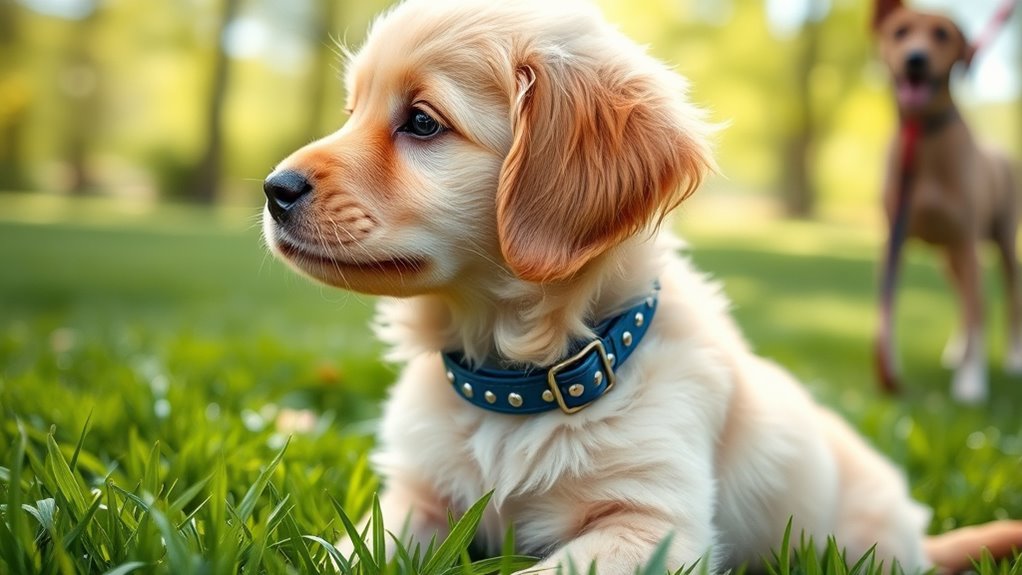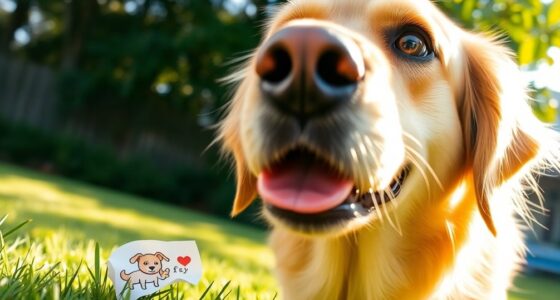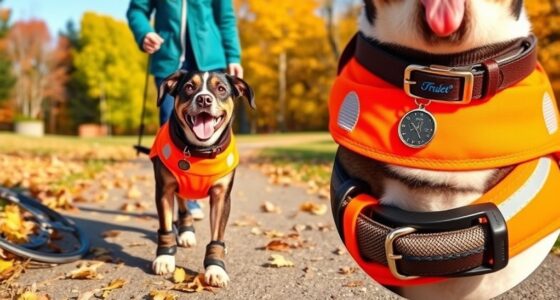To select the right collar or harness, consider your pet’s size, breed, and behavior. Opt for a durable, comfortable option like a nylon or leather collar for small dogs, and a sturdy harness for larger breeds. make sure it fits well—about two fingers should fit between the collar or harness and your pet’s neck or chest. Look for safety features like reflectiveness or quick-release buckles. Keep exploring to find the best fit and options for your furry friend.
Key Takeaways
- Select a collar or harness suited to your pet’s size, breed, and behavior for optimal safety and comfort.
- Ensure proper fit by leaving two fingers between the accessory and your pet’s neck or chest.
- Choose durable, pet-safe materials like nylon, leather, or eco-friendly options for longevity and comfort.
- Consider additional features such as reflective strips, GPS tags, or quick-release buckles for enhanced safety.
- Match the type of collar or harness to your training goals and activity level for effective control and ease of use.
Understanding Different Types of Collars and Harnesses
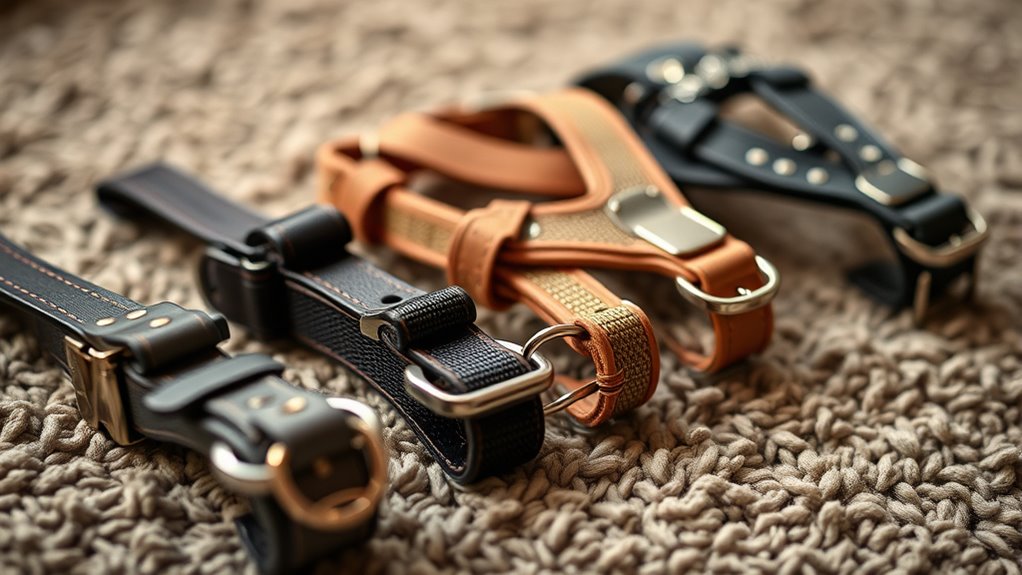
When choosing a collar or harness for your pet, understanding the different types available is vital. Collars vary from simple flat collars to martingale and choke chains, each offering different levels of collar safety. Flat collars are common and suitable for everyday wear, but you should always make sure they’re not too tight. Harnesses come in styles like step-in, front-clip, and back-clip, which can be more effective for harness training and reduce strain on your pet’s neck. Properly fitting a collar or harness is essential for safety and comfort. A well-chosen option helps prevent injuries and makes walks more enjoyable. Remember, the right type depends on your pet’s size, behavior, and your training goals, especially if harness training is part of your routine. Additionally, understanding trust issues in relationships can help pet owners build stronger bonds with their animals through consistent and honest interactions. Being aware of collar safety features can further ensure your pet’s comfort and security during walks. Considering latest safety innovations can also contribute to making the best choice for your pet’s well-being, especially as new safety features are developed to improve pet security.
Factors to Consider Based on Your Pet’s Size and Breed

Choosing the right collar or harness depends heavily on your pet’s size and breed. Larger breeds need sturdy, well-fitting options to guarantee pet safety and effective training techniques, while small breeds require lightweight, comfortable designs. Consider these factors:
- Strength and durability – Larger dogs need robust materials to prevent breakage during walks or pulls. Selecting appropriate materials can significantly impact the longevity and safety of the collar or harness. Using materials with high tensile strength ensures they withstand the force exerted by larger breeds.
- Fit and comfort – Proper sizing prevents chafing and ensures your pet feels secure. Ensuring a snug but not tight fit helps maintain comfort during extended wear.
- Breed-specific needs – Some breeds have necks or chests that require specialized harnesses for better control and safety. Consulting breed-specific guidelines can improve your choice.
- Technology and material composition – Modern material advancements improve durability and comfort for different breeds and sizes. These innovations can enhance the overall experience for your pet and make training more effective.
Choosing the Right Material for Comfort and Durability
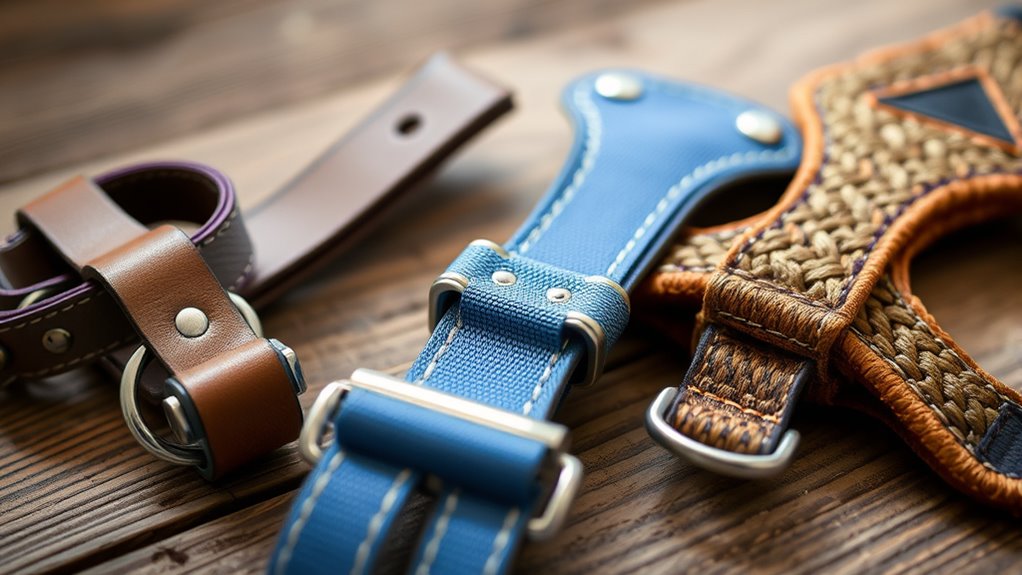
Selecting the right material for your pet’s collar or harness is essential to guarantee both comfort and durability. You want something that withstands daily wear while keeping your furry friend comfortable. Leather offers timeless elegance and strength, perfect for durability and style. Nylon is lightweight, easy to clean, and available in vibrant color options, making it a popular choice. Consider fashion trends too—bright hues or patterns can reflect your pet’s personality. Here’s a quick comparison:
| Material | Pros | Cons |
|---|---|---|
| Leather | Durable, stylish | Expensive, less flexible |
| Nylon | Lightweight, colorful | Less durable, can fray |
Choosing the right material balances fashion trends and practical needs for your pet’s comfort and longevity. Additionally, selecting a material that is vet-approved, ensures that it meets safety standards and provides peace of mind. When selecting materials, also consider how Volkswagen Tuning principles of quality and reliability can be metaphorically applied to choosing sturdy, dependable pet accessories.
A thoughtful choice of material can also help reduce the risk of environmental harm caused by less sustainable options, aligning your pet care with eco-friendly practices.
Ensuring Proper Fit and Adjustability

Ensuring your pet’s collar or harness fits properly is essential for safety and comfort. An ill-fitting collar risks collar safety, while an improperly adjusted harness can hinder harness training. To get the fit right, consider these key points:
Properly fitting collars and harnesses ensure your pet’s safety and comfort during every walk.
- Check that you can fit two fingers between the collar or harness and your pet’s neck or chest—this prevents it from being too tight or loose.
- Regularly adjust the fit as your pet grows or gains weight, maintaining comfort and safety.
- Make certain the harness sits snugly without restricting movement or breathing, especially during harness training sessions.
Proper fit not only keeps your pet safe but also promotes effective harness training, making walks more enjoyable for both of you.
Additional Features to Look For in a Collar or Harness
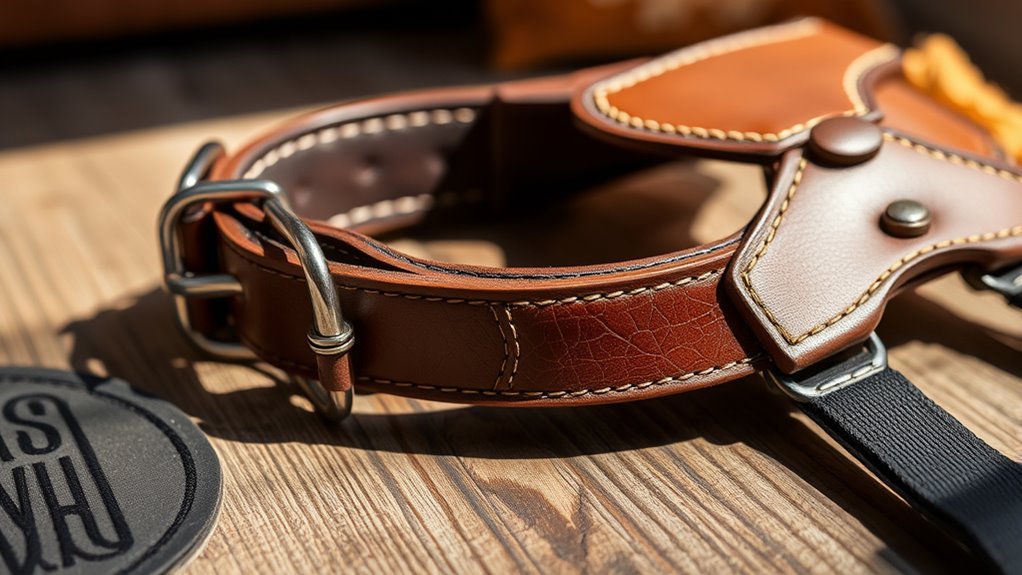
Adding extra features to your pet’s collar or harness can enhance safety, convenience, and comfort during walks. Look for collar safety features like reflective strips or GPS tags to increase visibility and security. These additions help keep your pet safe in low light or busy areas. When considering harness styles, choose options with quick-release buckles or padding for added comfort and easy adjustments. Some harnesses include leash attachment points at different locations, offering better control and reducing strain on your pet’s neck. Additional features like built-in ID tags or water-resistant materials can also be beneficial. Properly fitting eye patches can improve their effectiveness and comfort during use. Additionally, selecting collars and harnesses with adjustable straps ensures a better fit as your pet grows or if they have fluctuating sizes. Incorporating safety features such as reflective elements or breakaway buckles can further enhance your pet’s security. By choosing collars and harnesses with these features, you ensure your pet stays safe, comfortable, and easily manageable on every walk.
Frequently Asked Questions
How Often Should I Replace My Pet’S Collar or Harness?
You should replace your pet’s collar or harness when it shows signs of wear, like fraying or fading. Material durability plays a big role—if the material weakens, it can break easily. Also, consider seasonal replacement; for example, switch to a lighter harness during summer or a sturdier one in winter. Regularly check for fit and damage to keep your pet safe and comfortable.
Are There Specific Safety Standards for Pet Collars and Harnesses?
You’re right to ask if there are safety standards for pet collars and harnesses. Rest assured, reputable products meet strict material safety and design standards to keep your pet safe. These standards ensure durable materials, secure fastenings, and comfortable fit. Always choose items certified by recognized safety organizations, so you aren’t sailing close to the wind. Your pet’s safety is worth verifying all the boxes before making a purchase.
Can a Collar or Harness Impact My Pet’S Behavior or Training?
A collar or harness can definitely influence your pet’s behavior and training. The right choice can enhance training techniques by providing better control and comfort, reducing stress and behavioral issues. Conversely, an improper collar or harness might cause discomfort or anxiety, hindering progress. You should select one that fits well and supports positive reinforcement. This approach helps in shaping good behavior and making training sessions more effective and enjoyable for your pet.
How Do I Transition My Pet to a New Collar or Harness?
Imagine your pet is setting sail on a new adventure. To help them adapt to a new collar or harness, use gentle training tips and patience as your navigation tools. Start with short wear time, offering praise and treats to build positive associations. Gradually increase wearing time, employing adjustment techniques like checking fit and comfort. This smooth shift guarantees your pet feels secure and confident on their journey.
What Signs Indicate My Pet’S Collar or Harness Fits Improperly?
You’ll want to look for signs that your pet’s collar or harness fits properly. If it’s too tight, you might notice discomfort, skin irritation, or difficulty breathing. If it’s too loose, it could slip off or cause chafing. Confirm the material is safe and comfortable, and check that you can fit two fingers between the collar or harness and your pet’s neck or chest. Proper fit and material safety keep your pet happy and secure.
Conclusion
Choosing the right collar or harness keeps your pet safe and comfortable. Remember, a proper fit reduces the risk of injury—did you know that poorly fitted collars can cause discomfort or even choking? By considering your pet’s size, breed, and comfort, you’ll make a smart choice. Invest in quality materials and adjustable options to guarantee long-term use. With the right gear, your furry friend will enjoy every walk confidently and happily.

